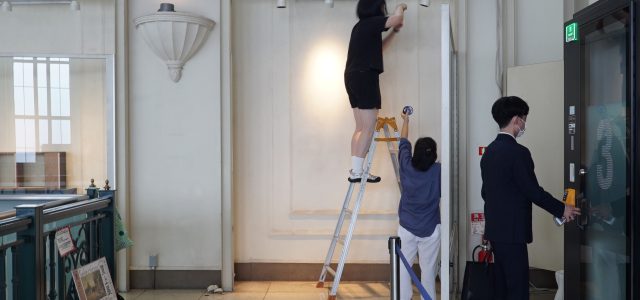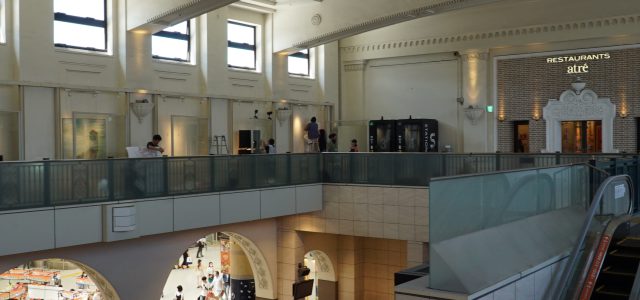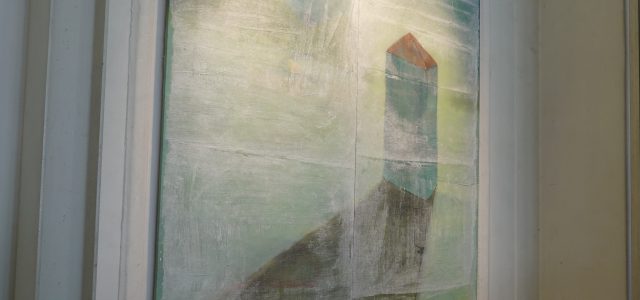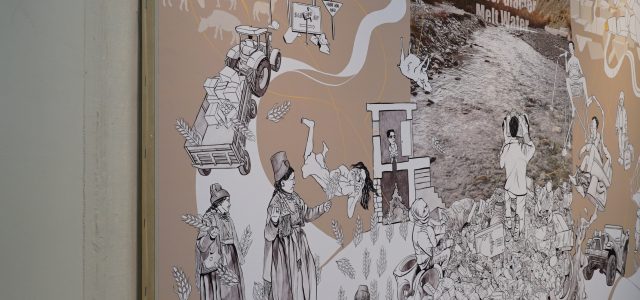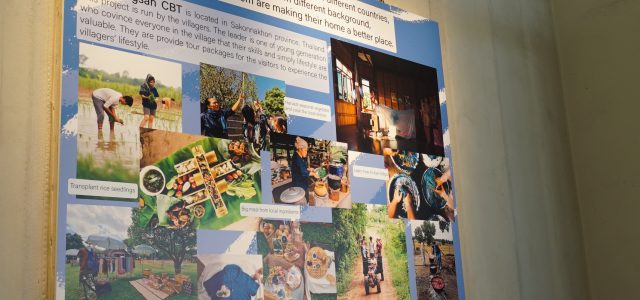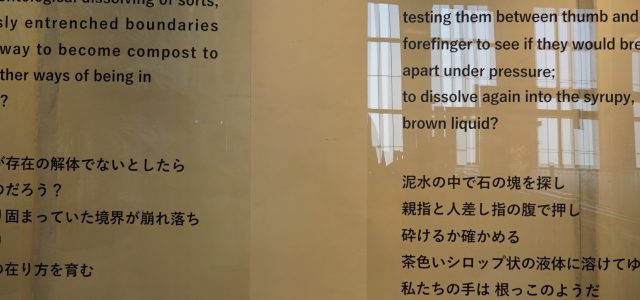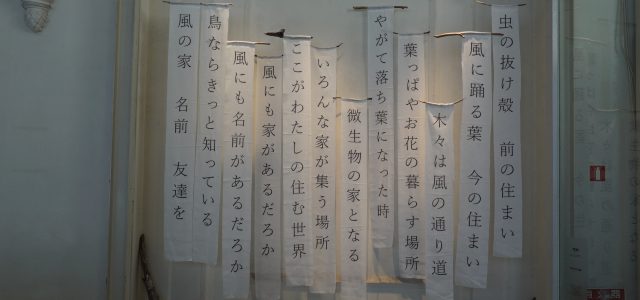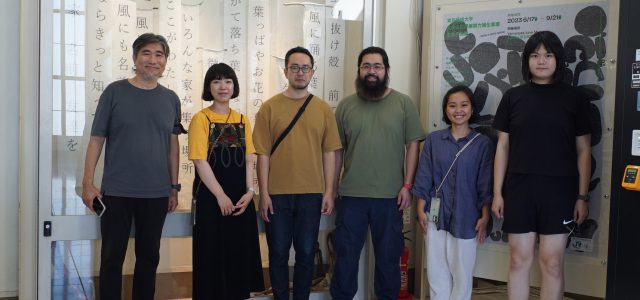【6/17-9/21 上野駅にて開催】SDGs X ARTs Geidai 大学の世界展開力強化事業 学生作品展のお知らせ[June 17th - 21 Sept. Ueno Station] SDGs X ARTs Geidai, Inter-University Exchange Program, Student Works 2023
June 15, 2023
SDGs X ARTs Geidai
東京藝術大学 大学の世界展開力強化事業 学生作品展
◻︎◻︎◻︎◻︎◻︎◻︎◻︎◻︎◻︎◻︎
開催期間|
2023 / 6 / 17(土)- 9 / 21(木)
開催場所|
Yamanote Line Museum
上野駅正面玄関口ガレリア
◻︎◻︎◻︎◻︎◻︎◻︎◻︎◻︎◻︎◻︎
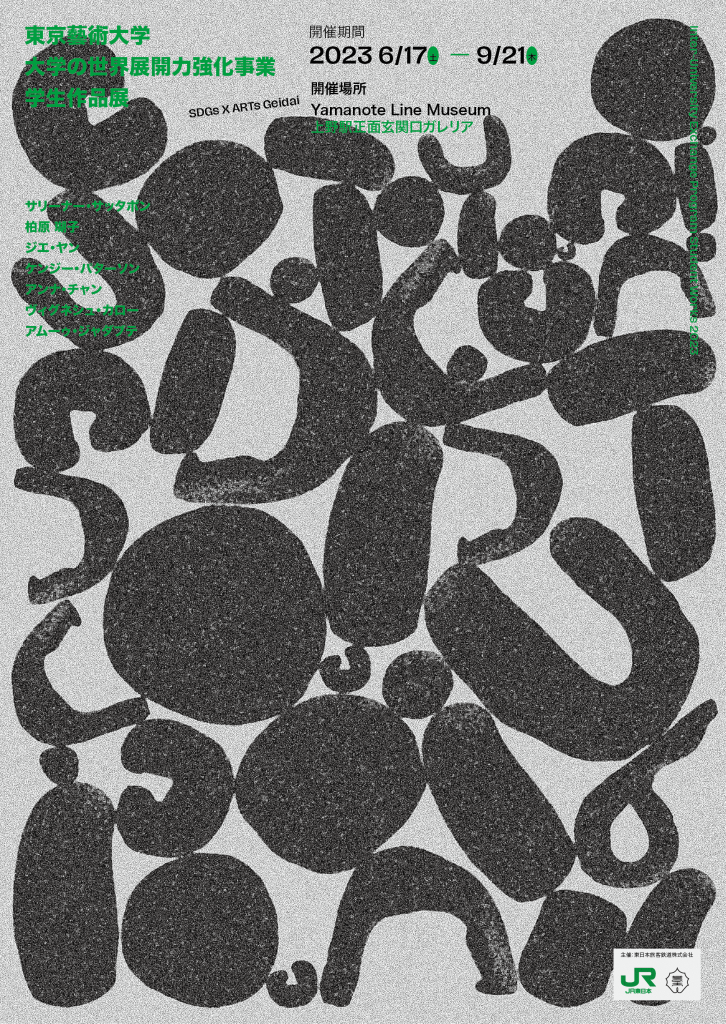
東京藝術大学では、2021年6月にSDGs推進室を設置し、SDGsの達成に貢献するための取組みを推進しています。
東京藝大が取り組む大学の世界展開力強化事業 SDGs X ARTs は、英豪印の大学、ロンドン芸術大学(イギリス)、モナッシュ大学(オーストラリア)、ナショナル・インスティテュート・オブ・デザイン(インド)と共に国際的な芸術大学の協働プラットフォームであるシェアード・キャンパスと協働してプログラムが2023年から5年間にわたって展開されるものです。
本展覧会は、2023年3月に開催されたプログラムへの参加学生の作品を紹介します。2023年3月はようやくコロナ禍が終わり、オーストラリア、インドから学生と教員が来日して事業を実施することができました。今後より多くの英豪印の学生たちがここ日本を訪れ、そして藝大生が相手国を訪れて、世界的なSDGsの課題に文化を超えて取り組むことが期待されています。
主催:東日本旅客鉄道株式会社
企画・運営: Yamanote Line Museum 上野駅正面玄関口ガレリア 展示事務局
監修:今村有策 (東京藝術大学副学長・大学院美術研究科グローバルアートプラクティス専攻 教授)
協力:東京藝術大学 グローバルサポートセンター
チラシ・ポスターデザイン:シゥイ・ウー (東京藝術大学大学院美術研究科グローバルアートプラクティス専攻博士前期課程在学)
お問合せ:uenoartgallery.ylm@gmail.com
【参加アーティストと出展作品コンセプト】
◾️サリーナー・サッタポン (Sareena Sattapon)
東京藝術大学院美術研究科グローバルアートプラクティス(GAP)専攻
無題
アーティスト自身の出身地であるタイと、現在の拠点の地である日本。それぞれお互い似ている点、異なる点があり、自国をより良いものにしようと試みている姿を作品では紹介する。
◾️柏原 瑚子 (Coco Kashiwara)
東京藝術大学院美術研究科グローバルアートプラクティス(GAP)専攻
《風はどこからくるのか》
虫が旅に出掛けた跡を見つけて、なんとなく「家」について考えはじめた。すると、ここはみんな「誰かの家」でできていることに気がつき、いつもよりずっとこの世界を好きになることができた。みんなの暮らしを辿る風にも、家があるだろうか? 普段その存在を直接見ることはできない。けれども目を閉じてみると、確かに頬に触れる風を、季節の香りや耳に届く音を通して感じることができる。今、あなたはどんな風を感じているだろうか。
◾️ジエ・ヤン(Jie Yang)
東京藝術大学院美術研究科グローバルアートプラクティス(GAP)専攻
《Green house with red roof(赤い屋根のある緑の家)》
本作品では人間が自然から切り離されているという通念を問い直し、代わり人間と自然との相互的かつ固有のつながりを重視する。この作品は人間と環境とのあいだの境界線を取り払う試みであると同時に、人間は孤立した存在ではなく、むしろ自然界の不可欠な一部であることを示す。その上で、人間と自然は相互に結びついていること、また環境問題への取り組みにおいて両者を共に考える重要性への理解を促すものである。
◾️ケンジー・パターソン(Kenzee Patterson)
モナシュ大学芸術デザイン建築学部博士課程
《Dissolving(分解)》
録音された文章はクリエイティブ・ノンフィクションのスタイルであり、講義や会話、展覧会や作品、ウェブサイト、科学論文などから得られた情報を含む。参照されているのは、講義、プレゼンテーションや会話、目にした展覧会や作品、Wikipedia、オーストラリア政府農水省のウェブサイト、そしてミーナル・ミシュラとバンダナ・サマントの科学論文「Feldspars: Life-Sustaining Minerals on the Earth」である。短期間で書かれたこの作品は、相互に関連する概念を含んでおり、命題でありながら逸脱もあり、完全な正解は存在しない。
◾️アンナ・チャン(Anna Chan)
モナシュ大学大学院建築学修士課程
《168 Hours(168時間)》
コミュニティ、生態系、そして資源の繊細なバランスの上にある複雑な関係の網の目を掘り下げた作品である。物語が展開するにしたがって、現代のエコロジー問題は従来の境界を超えており、単一のレンズや分野だけでは効果的な取り組みが不可能なことが明らかになっていく。鑑賞者は風景をシステム全体として観察し、自然の循環する季節のリズムを受け入れることになる。その上で、学際的で異文化的なアプローチが、持続可能性という枠組みの内部または外部で、芸術的実践により良い影響を与えるための方法を吟味するよう誘われるのだ。
◾️ヴィグネシュ・カローテ(Vignesh Karote)
インド国立デザイン大学陶芸・ガラスデザイン学科
《Yours Consciously(あなたの意識の中にあるもの)》
自然を愛しているが、快適さにとらわれて環境への影響を意識しているかが問われている。山頂まで車を走らせ、ファストフードやガソリンポンプなど、資源を大量消費するあらゆる製品や便利な道具を持ち込んでしまう。繊細で寒く、砂漠化した山岳地帯での生活を便利なものにし、息を呑むような自然の美を数週間かけて気軽に享受する。自然を封じ込め、それを冒険と呼んでいる。利便性が必ずしも問題というわけではない。消費のパターンや生態系とのつながりをどれだけ意識しているかが問題である。今、享受している快適さによって私たちは限りなく無関心なままなのだろうか?
◾️アムーゥ・ジャダブ(Amogh Jadhav)
インド国立デザイン大学プロダクト・デザイン学科
《Bioesse(バイオエッセ)》
バイオエッセンス(bio-esse-nce)とは、抽象的構成要素である数学と機械計算を用いて、あらゆる物質を探り自然の本質を理解しようとする試みである。エネルギー、物質、材料、空間、情報、時間といった基礎的な要素の理解や、未来への最適な問題解決のデザインへと向けた諸要素の組み合わせ、参加型アプローチや共同デザインなどを通じたさまざまな探究を行う。アリやミツバチが単純なルールで働き、それらが集まることで複雑かつ最適な構造を作り上げるような創造を目指している。
ここでは生体模倣とバイオニクスの草の根的なアプローチが、実験の方法論として用いられている。生成された物資的な人工物は彫刻的なオブジェとして、また探求されたパターン・原理を証明するものでもある。これらの人工物は、文脈にとらわれず、多様な使われ方や文脈への想像力を駆り立てるために作られている。
SDGs X ARTs Geidai
Inter-University Exchange Program,
Student Works 2023
◻︎◻︎◻︎◻︎◻︎◻︎◻︎◻︎◻︎◻︎
Date|
Sat. 17 June 2023 – Thu. 21 September
Venue|
Yamanote Line Museum
Galleria at the main entrance of Ueno Station
◻︎◻︎◻︎◻︎◻︎◻︎◻︎◻︎◻︎◻︎

Tokyo University of the Arts established the SDGs Promotion Office in June 2021 to contribute to the achievement of the SDGs.
SDGs X ARTs INTER-UNIVERSITY EXCHANGE PROJECT, a project by Tokyo University of the Arts to strengthen the university’s global development capabilities, is a collaborative platform of international art universities together with University of the Arts London (UK), Monash University (Australia), and National Institute of Design (India). This program will be developed in collaboration with Shared Campus, an international platform for art university collaboration, over a five-year period beginning in 2023.
This exhibition presents the works of students who participated in the program in March 2023. In March 2023, finally we were able to conduct the program with students and faculty members from Australia and India in Japan. It is expected that more British, Australian, and Indian students will visit Japan in the future, and that Geidai (TUA) students will visit their partner countries to engage in the issue of the global SDGs across cultures.
Organized by JR-EAST – East Japan Railway Company
Planned and organized by Yamanote Line Museum, Galleria at the Main Entrance of Ueno Station Exhibition Office
Supervised by Yusaku Imamura (Vice President, Professor of Global Art Practice, Graduate School of Fine Arts, Tokyo University of the Arts)
In cooperation with Global Support Center, Tokyo University of the Arts
Flyer and Poster designed by Wu Xiuyi ( Graduate School of Fine Arts, Tokyo University of the Arts, Global Art Practice, Master’s Program student)
Contact: uenoartgallery.ylm@gmail.com
【Artists and Concept of Artworks】
◾️Sareena Sattapon
Global Art Practice, Graduate School of Fine Arts, Tokyo University of the Arts (GAP)
Untitled
There are similarities and differences between Thailand and Japan but we both are trying to make our countries a better place.
◾️Coco Kashiwara
Global Art Practice, Graduate School of Fine Arts, Tokyo University of the Arts (GAP)
《Where does the wind come from?》
I found the traces of where the insects went traveling and somehow started to think about “home”. Then I realized that this place is all made of “someone’s home,” which made me love this world much more deeply. Would there be a home in the wind that would follow everyone’s lives? We cannot usually see it directly. But if you close your eyes, you can certainly feel the wind on your cheeks, through the scents of the seasons, and through the sounds that reach your ears. What kind of wind are you feeling now?
◾️Jie Yang
Global Art Practice, Graduate School of Fine Arts, Tokyo University of the Arts (GAP)
《Green house with red roof》
“Green House with Red Roof,” challenges or questions the notion that humans are separate from the natural environment. Instead, it emphasizes the interconnectedness and inherent connection between humans and nature. The artwork seeks to break down the perceived boundary between humans and the environment, suggesting that humans are not separate entities but rather an integral part of the natural world. It promotes the understanding that humans and nature are intertwined and should be considered together when addressing environmental issues.
◾️Kenzee Patterson
PhD candidate,Art, Design and Architecture, Monash University, Australia
《Dissolving》
This is an audio recording of a creative non-fiction text. In its fragmentary nature and in its multiple tones I am hoping to reflect something of the discussions, workshops and site visits that have been hosted by Tokyo University of the Arts during the four days of this first year of the Critical Ecologies exchange program. In this writing I reference conversations, lectures and presentations we’ve been a part of, exhibitions and artwork that I have viewed, Wikipedia, the Australian Government’s Department of Agriculture, Fisheries and Forestry website, and a scientific paper titled Feldspars: Life-Sustaining Minerals on the Earth written by Meenal Mishra and Bandana Samant. It was written in haste and encompasses many interconnected notions. It is propositional, tangential and not fully resolved. I hope that it contributes to an ongoing conversation within and beyond this Shared Campus exchange.
◾️Anna Chan
MA Architectuer, Monash University, Australia
《168 Hours》
“168 Hours” delves into the intricate web of relations between communities, ecosystems, and the delicate balance of resources. As the narrative unfolds, it becomes evident that contemporary ecological issues transcend conventional boundaries and cannot be effectively tackled through a single lens or discipline alone. The viewer is invited to observe landscapes as a whole system and embrace nature’s cyclical seasonal rhythms, and to assess ways in which interdisciplinary and intercultural approaches can positively inform artistic practices within the scheme of sustainability and beyond.
◾️Vignesh Karote
Ceramic and Glass Design, National Institute of Design, Ahmedabad, India
《Yours Consciously》
We love Nature! We would comfortably drive to remote regions in the world’s tallest peaks. And we import all our amenities, from packaged fast food, gas cylinders, supermarkets, concrete, petrol pumps, to other resource-intensive products, to make our lives easier in these fragile, cold, deserted mountain areas while effortlessly enjoying the last of nature’s breathtaking beauty for a few weeks. We’ve contained nature, and we call it an adventure. The problem isn’t necessarily convenience, but rather how conscious we are of our consumption patterns and connected with our ecosystems? Or are we blissfully ignorant of it because all the comforts we enjoy have made it invisible?
◾️Amogh Jadhav
Product Design, National Institute of Design, India
《Bioesse》
Bioesse (bio-esse-nce) is an inquiry of trying to understand the essence of nature by poking at the tangible materials of the universe through the abstract constructs of mathematics and computation. We sought to understand the fundamental elements such as Energy, Substance, Material, Space, Information, and Time, and how the entanglement of these elements could help in designing optimized solutions for the future. We explored many aspects of coming together through participatory approaches and co-designing. Similar to how ants or bees create – each individual works with a simple set of rules that come together to create complex optimized structures – we tried to ask how could we create in a similar way? A bottom-up approach to biomimicry and bionics was used as the methodology for experimentation. The physical artifacts generated stand as sculptural objects and as provocations of the various patterns and principles that have been inquired into. These artifacts are context-free and are made to spur the imagination toward diverse use cases and contexts.
#gallery-2 { margin: auto; } #gallery-2 .gallery-item { float: left; margin-top: 10px; text-align: center; width: 50%; } #gallery-2 img { border: 2px solid #cfcfcf; } #gallery-2 .gallery-caption { margin-left: 0; } /* see gallery_shortcode() in wp-includes/media.php */


